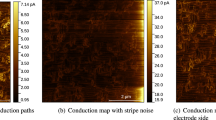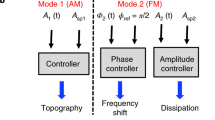Abstract
Atomic Force Microscopy (AFM) is a fundamental tool for the investigation of a wide range of mechanical properties on nanoscale due to the contact interaction between the AFM tip and the sample surface. The information recorded with AFM is stored and synthesized by imaging the sample properties to be studied. Distortions and unwanted effects in AFM images can be produced both due to instrumental sources or sample unknown bad responses. The focus of this paper is on an algorithm for distortion corrections for AFM recorded images due to the convolution of thermal drift and unknown polymer compliance. When a sequence of AFM images correspondent to the same polymeric area is acquired, it is common to observe the convolution of thermal drift with surface modifications due to the AFM tip stresses. The surface modifications are material properties and add knowledge to the response of the materials on nanoscale. As a consequence, a suitable de-convolution of the thermal drifts on the recorded images needs to be developed. Because soft polymeric samples can present unwanted height alteration due to the stressing AFM tip contact, we present a method that combines a thermal drifts correcting tool (where the original images are modified using a suitable mapping function) with a height rescaling method. In turn, an image matching method based on a Tikhonov functional is developed between topography data and the surface elastic maps, respectively. The precision achieved and the fast computation time required make our methods particularly useful for image analysis on soft polymeric samples as well as in a wide range of other scanning probe microscopy applications.
Similar content being viewed by others
References
V. Y. Yurov and A. N. Klimov, “Scanning Tunneling Microscope Calibration and Reconstruction of Real Image: Drift and Slope Elimination,” Rev. Sci. Instrum. 65(5), 1551–7 (1994).
A. Beyder, C. Spagnoli, and F. Sachs, “Reducting Probe Dependent Drift in Atomic Force Microscope with Symmetrically Supported Torsion Levels,” Rev. Sci. Instrum. 77, 1551–7 (2006).
S. M. Altmann, P. F. Lenne, and H. Horber, “Multiple Sensor Stabilization System for Local Probe Microscopes,” Rev. Sci. Instrum. 72, 142–149 (2000).
H. J. Hug, T. Yung, and H. J. Göntherodt, “A High Stability and Low Drift Atomic Force Microscope,” Rev. Sci. Instrum. 63, 3900–3904 (1992).
G. M. Clayton and S. Devasia, “Image-Based Compensation of Dynamic Effects in Scanning Tunneling Microscopes,” Nanotech. 16, 809–818 (2005).
S. Belikov, J. Shi, and C. Su, “AFM Image Based Pattern Detection for Adaptive Drift Compensation and Positioning at the Nanometer Scale,” in Proc. American Control Conf. (Seattle, 2008).
A. Rechichi, G. Ciardelli, M. D’Acunto, G. Vozzi, and P. Giusti, “Degradable Block Polyrethanes from Nontoxic Building Blocks as Scaffold Materials to Support Cell Growth and Proliferation,” J. Biomed. Mater. Res. A 84, 847–855 (2008).
R. Gonzalez and R. Wood, Digital Image Processing (Prentice Hall, Upper Saddle River, NJ, 2008).
S. Colantonio, I. B. Gurevich, and O. Salvetti, “A Two-Step Approach for Automatic Microscopic Image Segmentation Using Fuzzy Clustering and Neural Discrimination,” Pattern Recogn. Image Analysis 17, 428–437 (2007).
B. S. Salmons, D. R. Katz, and M. L. Trawick, “Correction of Distortion due to Thermal Drift in Scanning Probe Microscopy,” Ultramicroscopy 110, 339–349 (2010).
L. Lazzeri, M. G. Cascone, P. Narducci, N. Vitiello, M. D’Acunto, and P. Giusti, “Atomic Force Microscopic Wear Characterization of Biomedical Polymer Coatings,” Tribotest. 12, 257–265 (2006).
F. C. Flores and R. de Alecar Lotufo, “Watershed from Propagated Markers: An Interactive Method to Morphological Object Segmentation in Image Sequences,” Image Vision Comput. 28, 1491–1514 (2010).
B. K. P. Horn and B. G. Schunk, “Determining Optical Flow,” Artificial Intelligence 17, 185–204 (1981).
Y. Admit, “A Nonlinear Variational Problem for Image Matching,” SIAM J. Sci. Comput. 15, 207–224 (1994).
S. Henn and K. Witsch, “A Multigrid-Approach for Minimizing a Nonlinear Functional for Digital Image Matching,” Comput. 64, 339–348 (2000).
S. Henn and K. Witsch, “Iterative Multigrid Regularization Techniques for Image Matching,” SIAM J. Sci. Comput. 23, 1077–1093 (2001).
Y. Amit, U. Grenader, and M. Piccioni, “Structural Image Restoration through Deformable Templates,” J. Amer. Stati. Assoc. 86, 376–387 (1991).
A. Brandt, “Multi-Level Adaptive Solutions to Boundary Value Problems,” Math. Comp. 31, 333–390 (1977).
Author information
Authors and Affiliations
Corresponding author
Additional information
The article is published in the original.
Mario D’Acunto. M. Sc degree in Physics from the University of Pisa in 1994, PhD degree in Materials Science at the Dept of Mechanical and Nuclear Engineering, University of Pisa in 1999. Research Assistant grants at the Dept of Physics, Dept. of Chemical Engineering and Materials Science, Earth Science at the University of Pisa. Since 2009, he jointed the Italian National Research Council (CNR) involved in a European research project regarding the monitoring of oil spill for large marine areas His main interests include Statistics, Nonlinear dynamics, Bio-Nanotechnology, Neuroimaging, as well as experimental microscopy techniques ranging from the molecular scale to optical range such as Scanning Probe Microscopy, Electron Microscopy, etc.
Ovidio Salvetti. Director of research at the Institute of Information Science and Technologies (ISTI), National Research Council (CNR), Pisa. Working in the field of theoretical and applied computer vision. His fields of research are image analysis and understanding, pictorial information systems, spatial modeling, and intelligent processes in computer vision. Coauthor of four books and monographs and more than 300 technical and scientific articles, with ten patents regarding systems and software tools for image processing. Has served as a scientific coordinator of several national and European research and industrial projects, in collaboration with Italian and foreign research groups, in the fields of computer vision and high-performance computing for diagnostic imaging. Member of the editorial boards of the international journals Pattern Recognition and Image Analysis and G. Ronchi Foundation Acts. Currently the CNR contact person in ERCIM (the European Research Consortium for Informatics and Mathematics) for the Working Group on Image and Video Understanding and a member of IEEE and of the steering committee of a number of EU projects. Head of the ISTI Signals and Images Laboratory.
Rights and permissions
About this article
Cite this article
D’Acunto, M., Salvetti, O. Pattern recognition methods for thermal drift correction in Atomic Force Microscopy imaging. Pattern Recognit. Image Anal. 21, 9–19 (2011). https://doi.org/10.1134/S1054661811010056
Received:
Published:
Issue Date:
DOI: https://doi.org/10.1134/S1054661811010056




